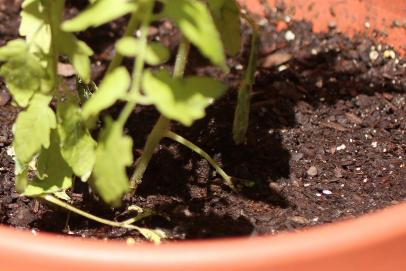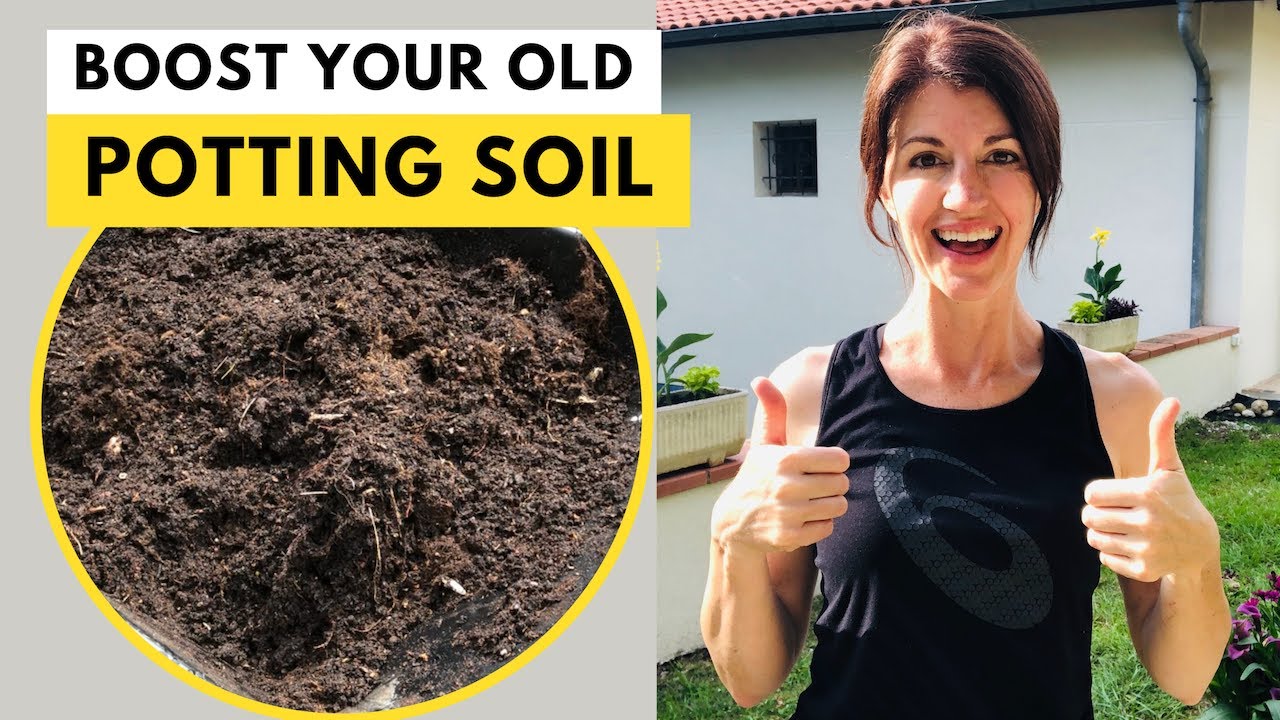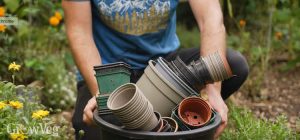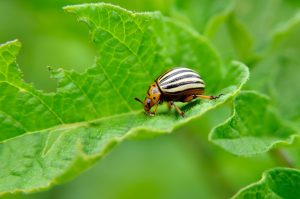To reuse potting soil, remove old plant material and mix in new compost. Ensure proper sterilization to eliminate pests and diseases.
Rejuvenating potting soil for another planting season can be both cost-effective and environmentally friendly.
Garden enthusiasts often face the challenge of ensuring their potting mix remains fertile and free of pathogens. Addressing this requires a clear, straightforward process that maintains the health of your next plants.
Revitalizing used soil involves removing old roots, replenishing nutrients, and safeguarding against contaminants. A strong focus on these practices not only bolsters plant growth but also aligns with sustainable gardening principles.
With a few simple steps, one can easily prepare their potting soil for reuse, contributing to a thriving garden that’ll benefit from a well-maintained growing medium.

Credit: m.youtube.com
The Lifecycle Of Potting Soil
Gardening is a joy that often involves potting and repotting plants. Potting soil is vital in this process. It nurtures your plants, giving them a home to grow and flourish. But what happens when the soil loses its zest? Understanding the lifecycle of potting soil is crucial in maintaining a healthy garden.
Signs Of Soil Exhaustion
Soil exhaustion occurs when nutrients deplete. Look for these signs:
- Plant growth slows and leaves may yellow.
- Pests or diseases could appear more frequently.
- The soil compacts, drains poorly, and dries out fast.
Typical Lifespan Of Potting Mix
The lifespan of a potting mix can vary:
| Type of Potting Mix | Lifespan |
|---|---|
| Regular Potting Soil | 6 months to 1 year |
| With Perennial Plants | 1 to 2 years |
| High-Quality Mixes | Up to 2 years, sometimes more |
For best results, refresh or replace your potting soil within these time frames. It ensures your plants remain happy and healthy.
Prepping Used Soil For Reuse
Have you ever wondered what to do with potting soil from last season’s plants? Reusing potting soil is both eco-friendly and cost-effective. Before planting anew, a little preparation is key. With a few simple steps, you can revitalize your used soil. This ensures healthy growth for your upcoming garden projects.
Removing Old Roots And Plant Matter
Begin by clearing out old roots and plant debris. These remnants can harbor pests or diseases. They could also prevent new roots from spreading out. Use your hands or a small tool to gently remove this material. Make sure to discard it away from your garden to avoid contaminating your new plants.
Breaking Up Compacted Soil
Next, focus on breaking up compacted soil. Soil compaction can deter proper aeration and water flow. This is crucial for root health. Use a fork or a trowel to loosen the soil. You want to achieve a crumbly, aerated texture. Consider adding some fresh potting mix or compost. This will help rejuvenate the soil’s structure and nutrient content.
| Action | Purpose | Benefit |
|---|---|---|
| Remove plant debris | Prevent disease and pests | Healthy new plant growth |
| Loosen compacted soil | Improve aeration and drainage | Stronger root systems |
Prepping your used potting soil helps create a thriving environment for your plants. Follow these steps, and you’re well on your way to a successful growing season!
Sanitizing Soil To Prevent Disease
Garden enthusiasts, listen up! Sanitizing soil is crucial to keep your plants healthy. It prevents the spread of diseases that can wreak havoc in your garden. Let’s make sure your green friends thrive by giving your potting soil a clean start.
Methods For Sterilizing Soil
Keep your plants safe with these simple soil sterilization techniques:
- Bake in the oven. Spread soil on a baking sheet. Heat at 200°F for 30 minutes.
- Steam with a pressure cooker. For small batches, steam at 10 PSI for 30 minutes.
- Use the sun. Place soil in clear bags, seal, and leave in the sun for 4-6 weeks.
Choose a method that fits your schedule and the amount of soil you need to treat.
Avoiding Common Soil Pathogens
Keep an eye out for these troublemakers:
| Pathogen | Host Plant | Signs |
|---|---|---|
| Fusarium | Tomatoes, Peppers | Wilted leaves, yellowing |
| Pythium | Cucumbers, Spinach | Root rot, stunted growth |
Prevent diseases by sanitizing your potting soil regularly and monitoring for signs of pathogens.

Credit: www.hgtv.com
Replenishing Nutrients In The Soil
Gardens thrive on rich soil, but after a growing season, potting soil can lose its vigor. Plants may start to look sad for the lack of nutrients. Let’s bring that soil back to life! Revitalizing your potting mix saves money and keeps your plants happy and healthy.
Organic Amendments To Restore Fertility
Your garden deserves the best. Rejuvenating potting soil with organic matter is like a health boost. It’s simple and benefits the environment. Think of it as a feast for your plants—and the critters that help them grow.
- Compost: Rich in nutrients, improves soil structure.
- Worm Castings: Encourages growth with micro-nutrients.
- Bone Meal: Boosts bloom with phosphorus.
- Blood Meal: Adds nitrogen, essential for green leaves.
N-p-k Ratio: What Does Your Plant Need?
Plants speak N-P-K, shorthand for their dietary needs. Nitrogen (N), phosphorus (P), and potassium (K) are the main course. The perfect mix depends on your plant’s stage and type.
| Plant Type | Nitrogen | Phosphorus | Potassium |
|---|---|---|---|
| Leafy Greens | High | Medium | Medium |
| Flowering Plants | Low | High | Medium |
| Fruit-Bearing Plants | Medium | Medium | High |
Check the label on fertilizer packages for numbers like 10-10-10. They show the N-P-K ratio. Tailoring this balance lets you customize your soil’s nutrient mix. It’s like a personalized diet plan for your plants.
The Role Of Ph Balance In Reused Soil
Mixing Old Soil With New
Green thumbs know that reusing potting soil is both eco-friendly and cost-effective. But did you know that mixing old soil with fresh substrate can yield even better results for your plants? This section delves into the art of blending used and new potting soils.
Benefits Of Combining Soils
Combining old and new potting soils rejuvenates your garden’s foundation. It offers nutrient-rich and structurally diverse mixtures. Below are the main benefits:
- Improved Drainage: New soil helps prevent waterlogging.
- Richer Nutrients: Fresh soil introduces essential nutrients.
- Cost Savings: Reduce expenses by using less new soil.
- Sustainable Gardening: Reuse to minimize waste.
Best Practices For Mixing Substrates
To ensure the healthiest mix for your plants, follow these steps:
- Remove Old Roots: Clear out remnants from previous plants.
- Sterilize if Necessary: Bake old soil to kill pathogens.
- Amend Soil: Add compost or fertilizer to rejuvenate.
- Correct pH Levels: Adjust pH to suit new plants.
- Mix Proportions: Use a 50/50 blend for balance.
Remember, the success of your garden starts with the quality of your soil. Use this knowledge to give your plants a vibrant and healthy growth environment!
Creative Ways To Reuse Potting Soil
The success of your garden can hinge on the balance of soil pH. It’s the unseen hero of growth and nutrition. When reusing potting soil, the pH levels set the stage for plant health. Let’s dive into ensuring it’s just right for another round of flourishing plants.
Testing Soil Ph Levels
Knowing the pH level of your soil is crucial. It tells you if it’s time to adjust for new plants. You can easily find soil pH testing kits at garden stores. Follow these simple steps:
- Gather a soil sample from your pot.
- Spread it on a clean surface to dry.
- Use the testing kit as directed.
- Note the pH level indicated.
Results in hand, you’ll know if your soil is ready or needs a tweak.
Adjusting Ph For Optimal Plant Health
If your soil’s pH isn’t ideal, don’t worry. Adjustments are simple.
For acidic soil (low pH), consider adding:
- Lime to raise the pH
- Dolomite for a slow-acting solution
To lower pH in alkaline soil:
- Sulfur or aluminum sulfate works well
- Pine needles or peat moss are natural options
Apply the amendments following package instructions. Test the soil again to ensure it’s in the 6.0 to 7.0 range, which suits most plants.
| pH Level | Condition | Amendment |
|---|---|---|
| < 6.0 | Acidic | Lime or Dolomite |
| > 7.0 | Alkaline | Sulfur or Organic Material |
With balanced pH, your reused soil becomes a nurturing home for your next plant adventure.
Gardeners know that potting soil is not a one-and-done deal. Rather than tossing out old soil, get creative and give it new life. Reusing potting soil is not just eco-friendly but also easy on the pocket. Let’s explore some ingenious ways to breathe new life into used potting soil.
Starting Seeds In Recycled Soil
Recycled potting soil makes an excellent starting point for your seeds. Before use, ensures the soil is disease-free and nutrient-rich. Begin with these simple steps:
- Sift the soil to remove old roots and debris.
- Mix it with new compost for a nutrient boost.
- Moisten the mix before placing it in seed trays.
- Plant seeds according to their needs.
The gentle texture of used potting soil is perfect for tiny seeds. Such soil often has a fine structure ideal for small roots to navigate.
Mulching And Top-dressing Gardens
Don’t let old potting soil sit idle. Use it as a mulch or top-dressing for garden beds. The benefits extend to both aesthetic and health aspects of the garden. Here’s how to do it:
- Spread the old soil around plants evenly.
- Layer it no more than a couple of inches thick.
- Water gently to help it settle in place.
The used potting soil serves as a barrier, conserving moisture and suppressing weeds. Over time, it will break down, adding structure and nutrients back to the earth.

Credit: m.youtube.com
Environmental And Economic Advantages Of Reusing Soil
Reusing potting soil offers significant benefits for both the planet and your wallet. Embracing this practice can lead to a healthier environment by limiting waste. It also reduces expenses in garden maintenance. Let’s explore the tangible environmental and economic advantages that make reusing soil a smart choice for gardeners everywhere.
Reducing Waste And Saving Money
Every gardener knows that buying new potting soil can be expensive. By reusing soil, you avoid purchasing new bags each season. This not only saves money but also cuts down on plastic waste from the bags. Here’s how:
- Cut down on landfill contributions: Used potting soil adds to the growing pile of waste.
- Recycle nutrients: Refreshing old soil can bring back nutrients, perfect for new plantings.
Simple steps like composting plant debris and mixing in new organic matter make old soil new again. Your garden blooms, and your wallet thanks you.
Sustainable Gardening With Recycled Materials
Sustainability is a buzzword for good reason. It’s about preserving our planet for future generations. Using recycled potting soil aligns perfectly with this concept. Know how:
- Reduce resource consumption: Harvesting materials for new soil depletes natural resources.
- Lower environmental footprint: Transportation of soil bags generates carbon emissions.
By incorporating old potting mix with compost or worm castings, you create a rich, sustainable growing medium. Your garden flourishes without extra resources. Together, let’s turn waste into wonder with smart soil sustainability.
Remember, gardens thrive on love and care. Reusing potting soil embodies that spirit, helping both nature and your budget in the process. Roll up your sleeves and let’s get our hands dirty – responsibly!
Frequently Asked Questions
How Do You Revitalize And Reuse Potting Soil?
Remove old plant roots and debris from the potting soil. Mix in new compost to reinvigorate nutrients. Add perlite or vermiculite to enhance drainage. Adjust soil pH with lime or sulfur if necessary. Water the revitalized mix before reusing for planting.
Is It Ok To Reuse Potting Soil?
Yes, reusing potting soil is acceptable with some preparation. Remove old plant roots and debris, then refresh the soil with compost or fertilizer before replanting to ensure a nutrient-rich environment for new plants.
How Do You Rejuvenate Potting Mix?
To rejuvenate potting mix, remove old plants and roots, then mix in compost, slow-release fertilizer, and vermiculite for aeration. Water lightly before reuse.
How Do You Revive Dried Potting Soil?
To revive dried potting soil, slowly moisten it with water, break up clumps, and mix thoroughly to restore even hydration. Avoid overwatering to prevent mold.
Conclusion
Repurposing potting soil is a savvy gardener’s move. It cuts costs and reduces waste, making your gardening more sustainable. Remember to refresh, sterilize, and balance the nutrients for optimal plant health. Embrace this eco-friendly practice, and watch your garden thrive with each season’s reuse.






3 Responses